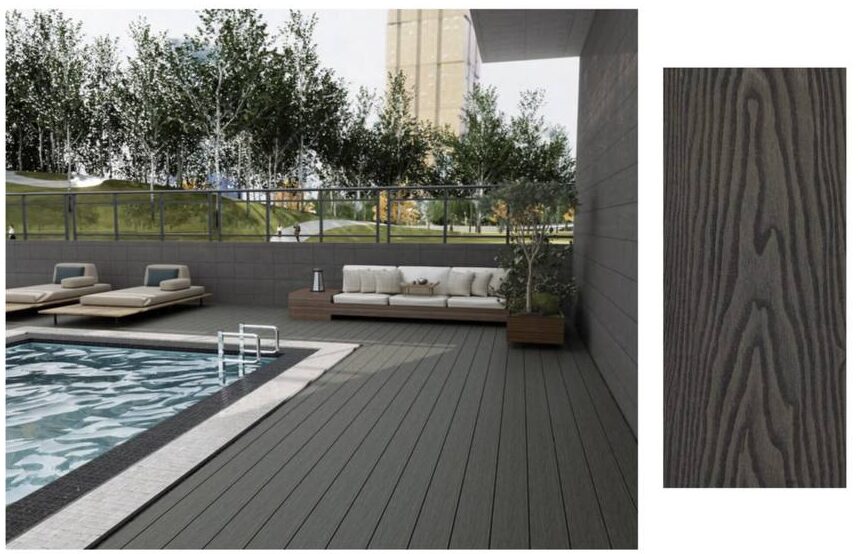PVC Outdoor Decking

PVC Outdoor Decking
PVC decking is a modern and highly durable flooring solution used for outdoor spaces such as backyards, patios, balconies, and pool areas. Made from 100% polyvinyl chloride (PVC) plastic, this decking contains no natural wood, making it completely waterproof, resistant to insects and mold, and easy to maintain.
Features and Characteristics of PVC Decking
✔ 100% Waterproof: Unlike wood and composite decking, PVC is entirely resistant to moisture.
✔ Mold and Mildew Resistant: Since it contains no organic materials, it doesn’t rot or develop mold.
✔ Insect and Termite Resistant: PVC has no appeal to termites or other wood-damaging insects.
✔ Long Lifespan: With a durability of 30 years or more, PVC outlasts wood and composite decking.
✔ Low Maintenance: No need for staining, sealing, or sanding—just clean with soap and water.
✔ Fade and Crack Resistant: Designed to withstand UV rays without discoloration or cracking.
✔ Easy and Quick Installation: Many PVC decking options feature snap-lock systems for hassle-free installation.
Advantages of PVC Decking
✅ Unmatched Water Resistance – Ideal for pools, patios, and humid environments
✅ Minimal Maintenance Required – No need for painting, sealing, or oiling like wood
✅ Exceptional Durability – No warping, rotting, or splitting over time
✅ Fast and Simple Installation – Many models feature modular and hidden fastening systems
✅ High Fire and UV Resistance – Retains its color and provides better safety than wood
Types of PVC Decking
- Solid PVC Decking
✔ Fully dense and non-hollow structure
✔ Highly resistant to impact and pressure
✔ Ideal for high-traffic areas
✔ Installed with hidden fasteners for a seamless look
- Hollow PVC Decking
✔ Lighter weight and easier installation
✔ More budget-friendly compared to solid PVC
✔ Suitable for residential and low-traffic areas
✔ Requires proper framing for added stability
Comparison: PVC vs. Composite vs. Wood Decking
Feature PVC Decking Composite Decking Wood Decking
Water Resistance 100% waterproof Water-resistant, but not 100% Susceptible to moisture damage
Insect & Termite Resistance Completely resistant High resistance Vulnerable to termites and pests
Maintenance Needs Minimal Occasional cleaning required Requires regular sealing and staining
Lifespan 30+ years 25-30 years 10-20 years
Eco-Friendliness Fully recyclable Contains recycled wood and plastic Natural wood, requires deforestation
How to Install PVC Decking
- Preparing the Foundation
- Ensure the ground is level and stable.
- Use metal or PVC-resistant framing for support.
- Maintain proper spacing between support beams for durability.
- Installing the Decking Boards
- Many PVC decking options use a snap-lock system or hidden screws for seamless installation.
- Leave expansion gaps between boards to accommodate temperature changes.
- Finishing Touches
- Use trim boards to cover cut edges.
- Add railings, LED lights, and decorative elements for an enhanced look.
How to Maintain PVC Decking
✔ Regular Cleaning: Wash with mild soap and water to remove dirt and debris.
✔ Avoid Scratches: Do not use sharp objects directly on the surface.
✔ Protect from Extreme Heat: Though UV-resistant, using shades or pergolas can prolong its lifespan.
Creative PVC Decking Design Ideas
- PVC Decking for Pool Areas
✔ Opt for light-colored boards to minimize heat absorption.
✔ Install non-slip decking for added safety.
✔ Add LED lights for stylish nighttime ambiance.
- PVC Decking for Patios and Balconies
✔ Choose wood-look finishes for a natural aesthetic.
✔ Combine with planters and vertical gardens for a green touch.
✔ Install pergolas or shade structures for extra comfort.
- PVC Decking for Backyards and Outdoor Living Spaces
✔ Pair with weather-resistant furniture for a cozy lounge area.
✔ Use PVC railings for added safety and aesthetics.
✔ Design walkways connecting different sections of your backyard.
Conclusion
PVC decking is one of the best choices for outdoor spaces due to its waterproof properties, durability, and minimal maintenance requirements.



